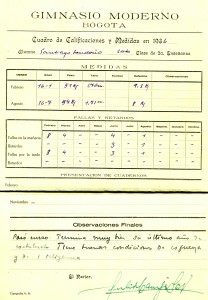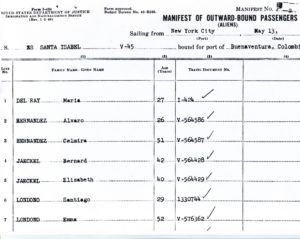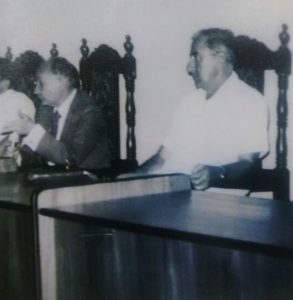On January 1st 2020, we celebrated the first birth centennial of the oncology physician Santiago Londoño Londoño. He was born in Pereira, Colombia where he spent most of his life and, as an arts supporter, philanthropist and leftist political leader, carried out several altruistic activities that impacted the region.
He specialized in radiotherapy, most likely in England, and practiced as a volunteer doctor in Cuba during the first years of the revolution. Londoño Londoño was also an active member of the World Peace Council. His participation took him to several countries, interacting with other peace activists, professionals and even heads of state.
To order your copy contact:
javier.amaya@hotmail.com
__________________________________________________________________________
Brief profile
Son of María Edma Londoño (Emma) born in Pereira in 1893 and prominent physician Santiago Londoño (1876-1950) from the region of Antioquia. His father was a personal medical assistant to General Rafael Uribe Uribe. His father was also a councilman, assembly representative, and co-founder of “La Golconda” a Liberal Party radical group in 1917. The father was a leader in adopting public health measures, attended graduate school in Paris, and donated valuable medical equipment to the public hospital in Pereira. He was also an active member of the masonic lodges and a firm advocate of the total separation of church and state.
*Graduate medical studies diploma for Dr. Londoño the father, by University of Paris in 1912. Londoño Family archives.
Violeta, Armando, Diego, as well as Jorge, Victor, Virginia, Mercedes, Alberto and Esperanza Ardila (children of Santiago’s father from another relationship), were his siblings.
Santiago Londoño attended high school as a board student at Gimnasio Moderno in Bogotá from 1931 to 1936 where he earned his diploma. This school emphasized a humanistic formation following the Montessori model, which promotes contact with nature and the integral development of the individual.
* School records were consulted thanks to the support of Camilo De-Irisarri Silva, academic official at Gimnasio Moderno in Bogotá.
While still an undergraduate student, in the winter of 1941 Santiago Londoño Londoño traveled in a group of 32 people from Universidad Nacional, to take courses at the University of Pennsylvania in Philadelphia and earned his certificate as a Visiting Fellow. He arrived just a couple of days before the Japanese attack on Pearl Harbor and the subsequent full involvement of the United States in the Second World War.
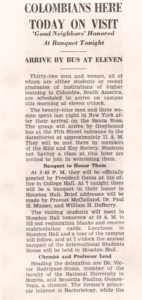 * The Daily Pennsylvanian commenting on the Colombian students arrival. December 4, 1941. Reproduced under permission.
* The Daily Pennsylvanian commenting on the Colombian students arrival. December 4, 1941. Reproduced under permission.
When Santiago was 25 years old he graduated from the School of Medicine at the Universidad Nacional in Bogotá in 1945, with a distinguished thesis on radiotherapy.
In their report titled “Intelectualidad cosmopolita en provincia: el caso de los Santiago Londoño en Pereira, Colombia” historians Martínez, Serna and Correa point that Santiago attended medical school from 1938 to 1945.
His graduating thesis was named: “Plástica facial en curieterapia focal externa” where Santiago illustrates the most recommended techniques to eradicate tumorous cancer in the head, designing features following human morphology, separating–with plastic instead of metal–the visibly affected areas from the healthy areas, and marking with some precision the treatment.
His thesis highlights Dr. Alfonso Esguerra, who was a leading researcher on the topic in his time. The young Santiago makes a detailed account on what was being discussed in important international forums and gives detailed numbers on treated cases, making important practical recommendations.
Years later, he attended graduate school in Europe. There he was trained and acquired costly equipment with his own funds, which he would later take to Pereira to benefit hundreds of patients and other fellow doctors interested in tumor therapy.
Co-founder with Carlos Drews Castro, Jorge Roa Martínez and other people of the Society of Friends of Art in 1947, inspiring music, dance, theater, painting, sculpture, and literature for several decades.
* Trip record with his mother Emma Londoño (lines 6 & 7) in the US flag SS Santa Isabel, departing from New York and heading to the port of Buenaventura. May of 1949.
He donates the first radiotherapy equipment to Hospital San Jorge in 1950. In the June 26, 1964 edition of the newspaper El Tiempo, a new contribution was noted: “Extremely valuable donation that has been calculated at approximately 800 thousand pesos, made this morning to Hospital San Jorge de Pereira, the prestigious doctor and specialist in cancer research, doctor Santiago Londoño Londoño…represented in all of the installations of his radium equipment, which are the most complete and modern…he just made it by way of written document…which arrived this morning to the offices of the Charity Board and the hospital administrators…”
Participates as a volunteer doctor in Santiago de Cuba, during the first years of the Cuban revolution.
Elected as a representative to the Regional Assembly in Risaralda for some terms in a left wing coalition in the seventies.
* Santiago Londoño Londoño, an elected member of the Regional Assembly .
He put together a special tribute to poet laureate Luis Vidales in 1979 after being arrested under the repressive government of Turbay Ayala. The event was attended by then Bishop of Pereira Darío Castrillón and former chancellor Alfredo Vásquez Carrizosa.
Santiago was a distinguished member of the World Peace Council. He attended several of their international meetings in Athens, Leningrad and New Delhi, demanding nuclear disarmament and distension among the world powers. He funded “Casa de la Amistad con los Pueblos” that he co-directed with journalist and lawyer César Augusto López Arias in support of other social processes, alternative artists, and other cultures.
Londoño supported initiatives for public art, like the acquisition of “Bolívar Desnudo” by Rodrigo Arenas Betancourt and many other cultural projects. In his book Pereira, historian Hugo Angel Jaramillo describes how the contract with the sculptor almost collapsed in part due to the opposition by the Governor of Caldas: “…a new contract was made in Colombian pesos putting an advance of forty thousand pesos from the time, donated among others by Santiago Londoño, the communist doctor, adorable and harmless, the generous Alfonso Jaramillo Bernal, Ernesto Gutiérrez Arango and Jaime Londoño Arango.”
Santiago Londoño in his own words.
Despite being a public personality, Santiago didn’t talk much about his personal motivations. In an interview given to journalist Marta González Villegas and published at La Tarde in April 20 1976, Santiago Londoño describes how he embraced a political ideology that he followed until his death.
When was Santiago Londoño, the communist born?
I was an advanced student of medicine and when coming back from school we were blocked – when traveling in the streetcar by a demonstration of people, who were yelling things, and we couldn’t keep going. I arrived late and tired to my apartment because we had to walk a lot. I met with a friend and told him: I arrived late to my appointment with you because there was a demonstration of some poorly dressed people, yelling horrible things, and I couldn’t make it on time. What’s going on? My friend, an advanced law school student, told me: look, these people demand these and other things.
What were they demanding?
They were asking for public liberties, salary raise, and changes in laws that affected them a lot and then, I understood the reasons for the demonstration. My friend explained to me in detail that those people were right.
What year did that happen?
It would have been about 1945. I kept talking to my friend for a long time; we talked and at about one in the morning, I told him: Look, if those people and what you told me is right I’m going to join that party. Then I went to look for books, I read, and a month later I went to join the Communist Party, and my career started.
Santiago Londoño, a peace advocate.
In the same interview in 1976, Santiago Londoño seems to talk to us in present tense on the significance of reaching peace:
For the communists, for opposition parties, for revolutionary parties the most precious gift is peace. We can’t do things, if not in peace.
We hope to build a new country, educate people, build wealth and all of that can’t be accomplished but in times of peace. Therefore, before everything we are fighters for peace.
About 25 years ago the World Peace Movement was founded in the world, and now precisely at the end of last year I had the chance to travel for the celebration of its twenty five years. The first meeting was in Athens and the central theme was the solidarity with the Chilean people who were living under a typically fascist dictatorship.
*Radiology Physicians’ Congress in Colombia, 1972. From the archives of historian Jhon Jaime Correa Ramirez.
Santiago’s support to reach peace was more than intellectual posture or a gesture to embrace a humanistic cause. As a physician Santiago knew the horrors of war firsthand. On more than one occasion, faithful to the Hippocratic Oath to protect life, he assisted injured combatants belonging to armed opposition groups. Such testimony was heard publicly many years later by lawyer and personal friend Arturo Sanín, during the legal proceedings in the defense of Santiago’s last will.
The physician put at risk his own life if we consider the Colombian army’s long history of using scorched earth tactics. Helping a dying fighter for humanitarian reasons easily could have ended Santiago’s life as a “false positive,” with no respect to his duties of noncombatant.
*Interview with the attorney and personal friend Arturo Sanín in August 2015.
Significant loss
Santiago died on August 1st, 1982 in a motorcycle accident in Zarzal. No investigation was carried on his dead, despite the evident negligence in providing first aid by the Emergency Services in Zarzal.
Years later, Pereira’s municipal theater adopted his name to honor the philanthropist, the arts supporter, the civic figure and the political leader who always advocated for the city and his fellow citizens.
Translation and proofreading by Courtney Moreno and Javier Amaya.
Last update: 06-28-2020
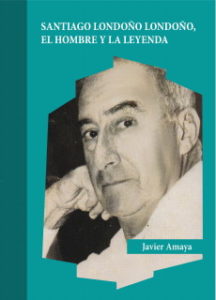 Cover of the first biography of Santiago Londoño Londoño in book format released in 2020 in Spanish, with foreword by historian Jhon Jaime Correa PhD with contributions by journalist Marta Gonzalez Villegas and movie critic German Ossa.
Cover of the first biography of Santiago Londoño Londoño in book format released in 2020 in Spanish, with foreword by historian Jhon Jaime Correa PhD with contributions by journalist Marta Gonzalez Villegas and movie critic German Ossa.
